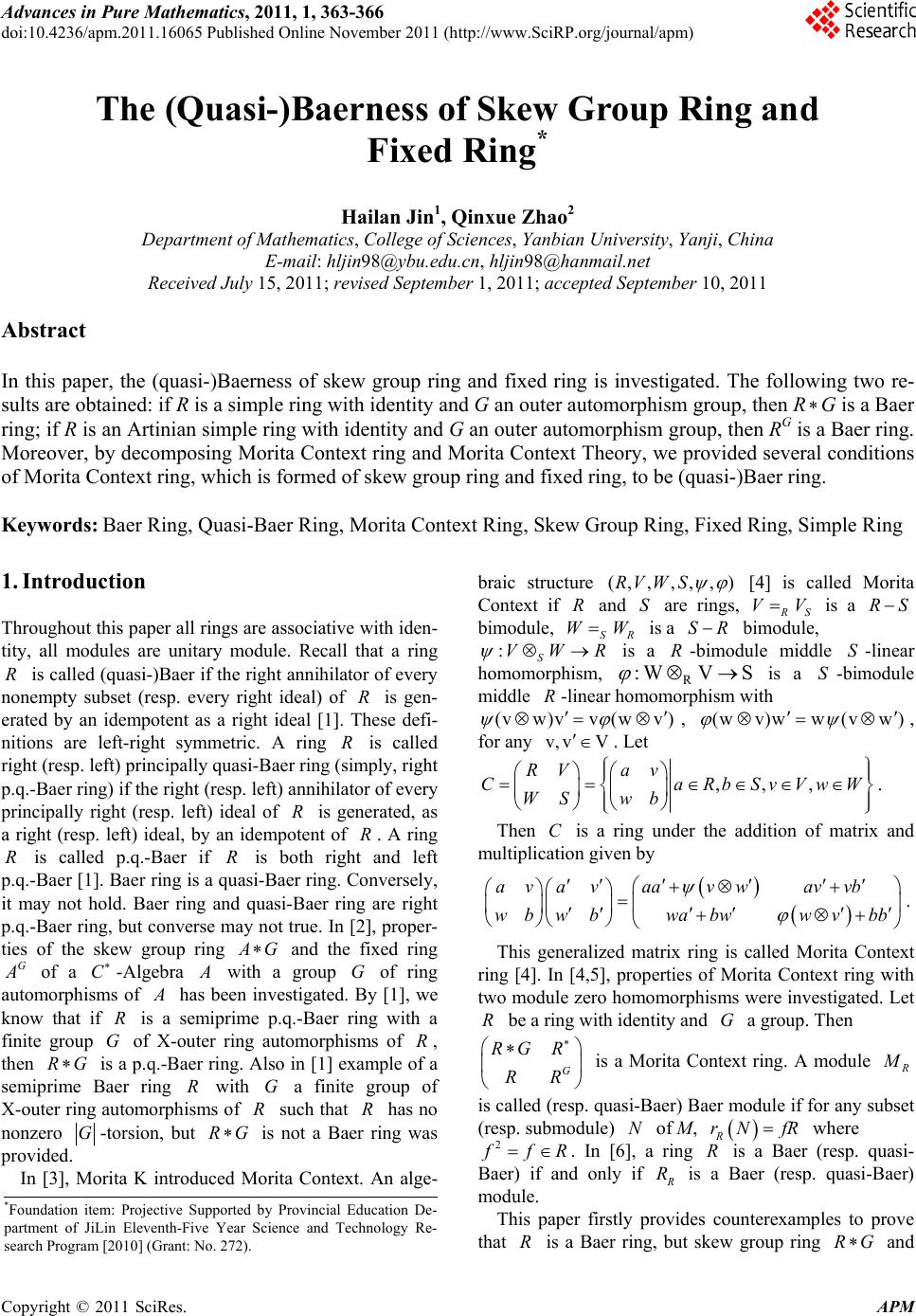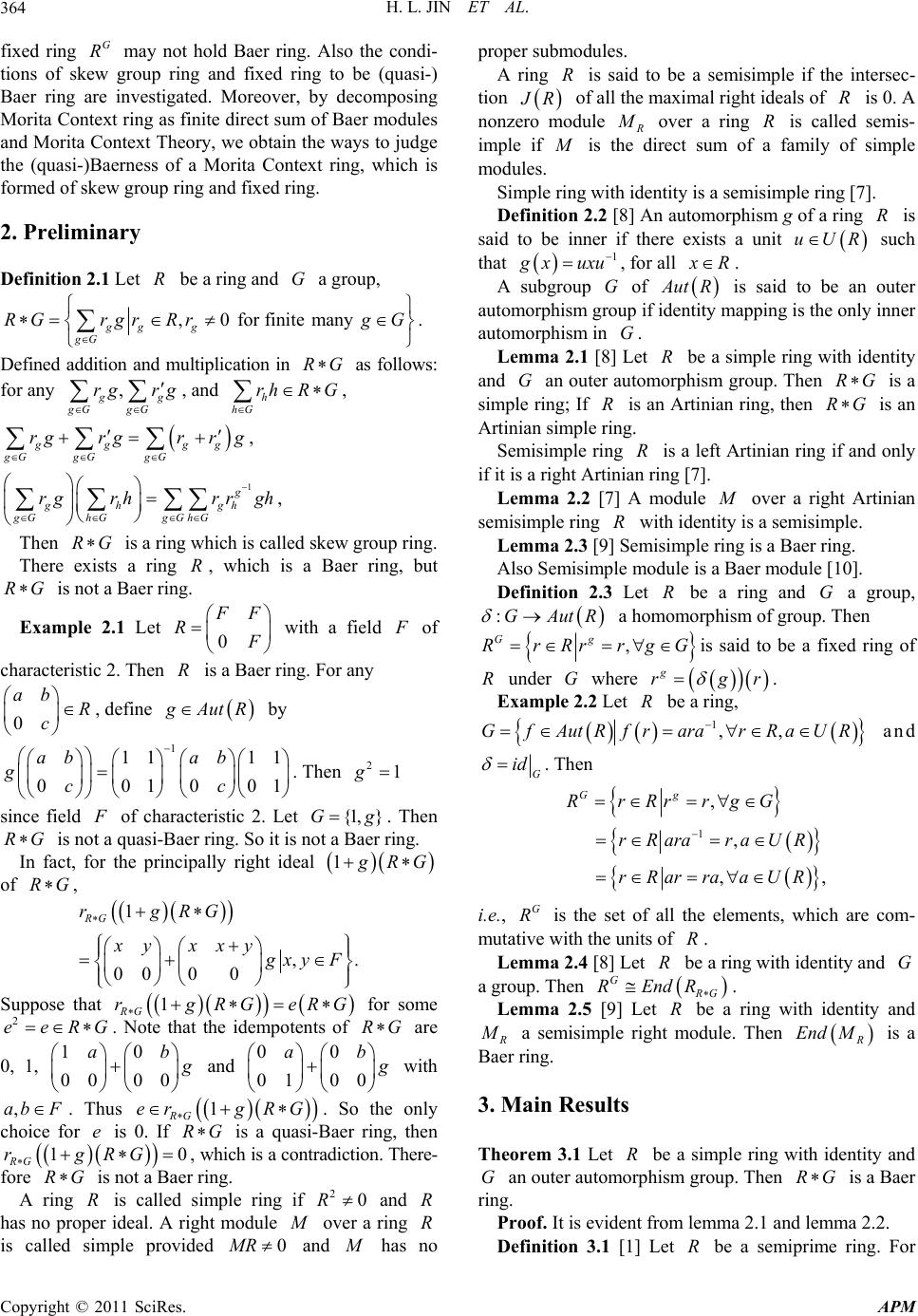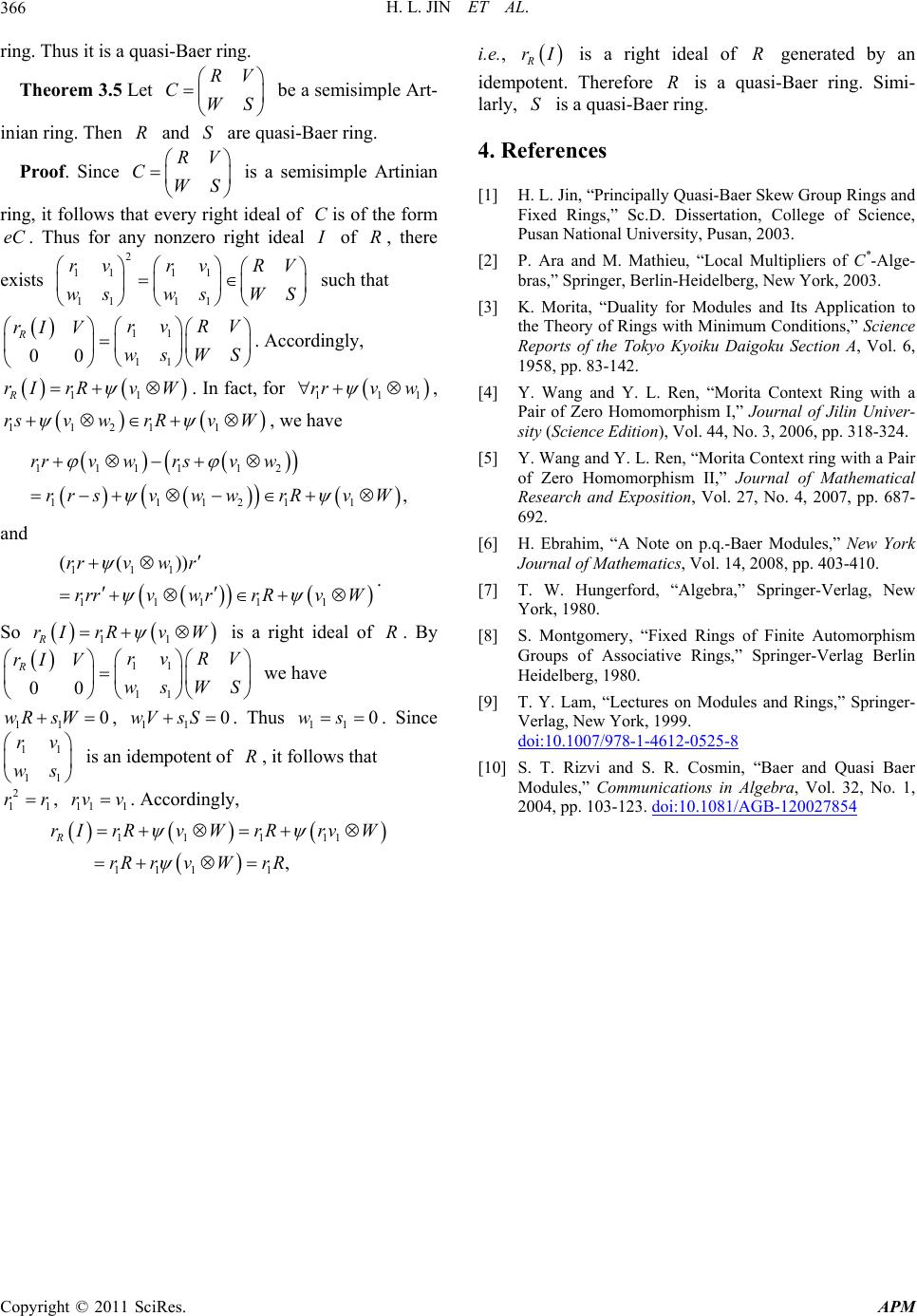 Advances in Pure Mathematics, 2011, 1, 363-366 doi:10.4236/apm.2011.16065 Published Online November 2011 (http://www.SciRP.org/journal/apm) Copyright © 2011 SciRes. APM The (Quasi-)Baerness of Skew Group Ring and Fixed Ring* Hailan Jin1, Qinxue Zhao2 Department of Mat hematics, Col l ege of Scie nces , Yanbian University, Yanji, China E-mail: hljin98@ybu.edu.cn, hljin98@hanmail.net Received July 15, 2011; revised September 1, 2011; accepted Septembe r 10, 2011 Abstract In this paper, the (quasi-)Baerness of skew group ring and fixed ring is investigated. The following two re- sults are obtained: if R is a simple ring with identity and G an outer automorphism group, then RG is a Baer ring; if R is an Artinian simple ring with identity and G an outer automorphism group, then RG is a Baer ring. Moreover, by decomposing Morita Context ring and Morita Context Theory, we provided several conditions of Morita Context ring, which is formed of skew group ring and fixed ring, to be (quasi-)Baer ring. Keywords: Baer Ring, Quasi-Baer Ring, Morita Context Ring, Skew Group Ring, Fixed Ring, Simple Ring 1. Introduction Throughout this pape r all rings are associative with iden- tity, all modules are unitary module. Recall that a ring is called (quasi-)Baer if the right annihilator of every nonempty subset (resp. every right ideal) of is gen- erated by an idempotent as a right ideal [1]. These defi- nitions are left-right symmetric. A ring is called right (resp. left) principally quasi-Baer ring (simply, right p.q.-Baer ring) if the right (resp. left) annihilator of every principally right (resp. left) ideal of is generated, as a right (resp. left) ideal, by an idempotent of . A ring is called p.q.-Baer if is both right and left p.q.-Baer [1]. Baer ring is a quasi-Baer ring. Conversely, it may not hold. Baer ring and quasi-Baer ring are right p.q.-Baer ring , but converse may no t true. In [2], prop er- ties of the skew group ring R R R R R R R G and the fixed ring G of a -Algebra C with a group of ring automorphisms of G has been investigated. By [1], we know that if is a semiprime p.q.-Baer ring with a finite group of X-outer ring automorphisms of , then is a p.q.-Baer ring. Also in [1] example of a semiprime Baer ring with a finite group of X-outer ring automorphisms of such that has no nonzero R G R RG RG R R G-torsion, but is not a Baer ring was provided. RG In [3], Morita K introduced Morita Context. An alge- braic structure (,, ,,,)RVWS S [4] is called Morita Context if and are rings, R S V is a VRS bimodule, SR WW is a bimodule, SR R:S VW is a -bimodule middle -linear homomorphism, R R :W VS S (wv) is a -bimodule middle -linear homomorphism wit h S R (v w)vv (w, v)ww(vw) , for any v,v V . Let ,,, RV av CaRbSv WS wbVwW . Then is a ring under the addition of matrix and multiplication given by C aav wavvb av av wabww vbb wb w b . This generalized matrix ring is called Morita Context ring [4]. In [4,5], properties of Morita Context ring with two module zero homomorphisms were investigated. Let be a ring with identity and a group. Then R G G RG R RR is a Morita Context ring. A module is called (resp. quasi-Baer) Baer module if for any subset (resp. submodule) of M, where N R rN fR 2 fR . In [6], a ring is a Baer (resp. quasi- Baer) if and only if R R is a Baer (resp. quasi-Baer) module. *Foundation item: Projective Supported by Provincial Education De- artment of JiLin Eleventh-Five Year Science and Technology Re- search Program [2010] (Gra nt: No. 272). This paper firstly provides counterexamples to prove that is a Baer ring, but skew group ring RRG and  H. L. JIN ET AL. 364 fixed ring may not hold Baer ring. Also the condi- tions of skew group ring and fixed ring to be (quasi-) Baer ring are investigated. Moreover, by decomposing Morita Context ring as finite direct sum of Baer modules and Morita Context Theo ry, we obtain the ways to judge the (quasi-)Baerness of a Morita Context ring, which is formed of skew group ring and fixed ring. G R 2. Preliminary Definition 2.1 Let be a ring and a group, RG ,0for finitemany gg g gG r gG rg RGgrRrg G . Defined addition and multiplication in as follows: RG for any , and , gg gG rg h hG rhR G , gg gG gG rggrr g gg gG r gh hG r RG , 1 g gh gG gGhG rghrr gh , Then is a ring which is called skew group ring. There exists a ring , which is a Baer ring, but is not a Baer ring. R RG Example 2.1 Let 0 F R with a field of characteristic 2. Then is a Baer ring. For any R 0 ab c R, define Aut R by 1 11 11 00100 ab ab gcc 1 . Then 21g since field of characteristic 2. Let . Then is not a quasi-Baer ring. So it is not a Baer ring. {1, }Gg RG In fact, for the principally right ideal 1 RG of , RG 1 ,. 000 0 RG rgRG xy xxy xy F G RG Suppose that for some . Note that the idempotents of 1 RG rgRGeR 2 ee RG are 0, 1, 1 00 0 00 ab and 00 01 00 ab with ,abF RG . Thus . So the only choice for is 0. If is a quasi-Baer ring, then RG, which is a contradiction. There- fore is not a Baer ring. 1 RG er gRG RG 0RG e 1 R rg A ring is called simple ring if and has no proper ideal. A right module 20RR over a ring is called simple provided and R 0MR has no proper sub modules. A ring is said to be a semisimple if the intersec- tion R R of all the maximal right ideals of is 0. A nonzero module R over a ring is called semis- imple if R is the direct sum of a family of simple modules. Simple ring with identity is a semisimple ring [7]. Definition 2.2 [8] An automorphism g of a ring is said to be inner if there exists a unit R uUR such that 1 xuxu , for all R . A subgroup G of ut R is said to be an outer automorphism group if identity mapping is the only inner automorphism in . G Lemma 2.1 [8] Let be a simple ring with identity and an outer auto morphism group. Then R GRG is a simple ring; If is an Artinian ring, then RRG is an Artinian simple ring. Semisimple ring is a left Artinian ring if and only if it is a right Artinian ring [7]. R Lemma 2.2 [7] A module over a right Artinian semisimple ring with identity is a semisimple. R Lemma 2.3 [9] Semisimple ring is a Baer ring. Also Semisimple module is a Baer module [10]. Definition 2.3 Let be a ring and G a group, R :GAutR a homomorphism of group. Then ,RrRrrgG Gg is said to be a fixed ring of R under G where g rg Rr. Example 2.2 Let be a ring, 1,,GfAutRfrararRaUR and G id . Then 1 , , ,, Gg RrRrrgG rRararaUR rRarraaUR i.e., is the set of all the elements, which are com- mutative with the units of . G RR Lemma 2.4 [8] Let be a ring with identity and a group. Then R G GRG REdR n R. Lemma 2.5 [9] Let be a ring with identity and a semisimple right module. Then End M is a Baer ring. 3. Main Results Theorem 3.1 Let be a simple ring with identity and an outer automorphism group. Then is a Baer ring. R GRG Proof. It is evident from lemma 2.1 and lemma 2.2. Definition 3.1 [1] Let be a semiprime ring. For R Copyright © 2011 SciRes. APM  H. L. JIN ET AL.365 Aut R, let , rg g QRxrrxrR . Then automorphism g of ring is called X-outer if R 0 g . A subgroup of G ut R is called X-outer if every 1 G UR is a X-outer. Theorem 3.2 Let be a semiprime ring and a X-outer automorphism group. If is a simple ring with identity, then is a Baer ring. R RG R G R , Proof. Simple ring with identity is a semisimple ring. It is evident from lemma 2.2. Example 3.1 There exists a Baer ring with is not Baer ring. Let be a ring defined in example RG R 2.1. Then . For 10 01 11 01 0 ab R c ac 10 01 R , if , then . Thus by example 2.2. All the idempotents of are and . However, for , , where 11 11 10 1 11 0 0 G R 01 00 G R 0, G 00 ab 00 00 G R 01 00 G R 2G eeR G R 1 a 1 1 00 0 0 00 re R 0 b cc 0 , 1 G 0 ,, 1 0 00 R G R R 0 00 G . Therefore, is not a Baer ring. R Theorem 3.3 Let be a simple ring with identity and an outer automorphism group. If is an Artinian ring, then is a Baer ring. R Proof. By lemma 2.1 is a simple ring since is a simple ring with identity and an outer auto- morphism group. If is an Artinian ring, then GRG is an Artinian simple ring with identity. Consequently, is an Artinian semisimple ring. By lemma 2.4, RG G is a semisimple module. So R G is a Baer ring by lemma 2.5. Moreover, is a Baer ring by lemma 2.3. End G RR Theorem 3.4 Let be a Morita Context RV WS rv R ws 0 V C W ring. If and are right Artinian simple ring, then is a Baer ring. R C 11 00 rv 00 00 rv S Proof. For any , , , we have V S 0 C 00 00 rv 00 R 1 0 r V 1 0 0 v R , and 00 00 00 00 () 000 rv rv ws rrvwrvvsR V . So is a right ideal of . Similarly, is a right ideal of . Because for any , 00 RV rv ws 00 WS C V S R W 0000 0000 rv rvRV ws wsWS , and 00 0. 00 RV WS 00 RV RV WS k Thus . is the direct sum of minimal right ideals 00 WS R since is a right Artinian simple ring, where R 1, ,km , . Since m 00 kk JV 00 RV 00 WS C is a minimal right ideal of , it follows that is the direct sum of simple module. It is similar to . Thus C is the direct sum of several simple module. Consequently, is a semisimple module. Since semisimple module is a Baer module and a Baer module. Therefore, it is a Baer ring. C RV WS RV WS Baer ring is a quasi-Baer ring. Accordingly, if R and are simple module, then is a quasi-Baer ring. S S C Example 3.2 Let R be a ring with identity and G group. Obviously, Ris a bimodule. Let a G RRG , G . Then is a bimodule. For any , define: R RHomR ,, R G RG rs R ,R G RG R :G R RRR G , ss ; :G RG RRR , 11 RR rr r . Then G RG R RR is a Mo rita Context ring. By lem- ma 2.1 if is an Artinian simple ring with identity and an outer automorphism group, then and R GRG G R are simple ring. By theorem 3.4 is a Baer G RG R RR Copyright © 2011 SciRes. APM  H. L. JIN ET AL. Copyright © 2011 SciRes. APM 366 i.e., R rI S is a right ideal of generated by an idempotent. Therefore is a quasi-Baer ring. Simi- larly, is a quasi-Baer ring. R R ring. Thus it is a quasi-Baer ring. Theorem 3.5 Let be a semisimple Art- RV CWS inian ring. Then and are quasi-Baer ring. R S4. References Proof. Since is a semisimple Artinian RV CWS [1] H. L. Jin, “Principally Quasi-Baer Skew Group Rings and Fixed Rings,” Sc.D. Dissertation, College of Science, Pusan National University, Pusan, 2003. ring, it follows that every right ideal of is of the form . Thus for any nonzero right ideal C eC of , there R[2] P. Ara and M. Mathieu, “Local Multipliers of C*-Alge- bras,” Springer, Berlin-Heidelberg, New York, 2003. exists such that 2 11 11 11 11 rvrv RV wsws WS [3] K. Morita, “Duality for Modules and Its Application to the Theory of Rings with Minimum Conditions,” Science Reports of the Tokyo Kyoiku Daigoku Section A, Vol. 6, 1958, pp. 83-142. 11 11 00 Rrv RV rI V wsWS . Accordingly, 11R rIrRv W . In fact, for 11 rrv w 1 , , we have 1121 rsv wrR 1 v W 111112 111211 , rrvw rsvw rr svwwrRvW [4] Y. Wang and Y. L. Ren, “Morita Context Ring with a Pair of Zero Homomorphism I,” Journal of Jilin Univer- sity (Science Edition), Vol. 44, No. 3, 2006, pp. 318-324. [5] Y. Wang and Y. L. Ren, “Morita Context ring with a Pair of Zero Homomorphism II,” Journal of Mathematical Research and Exposition, Vol. 27, No. 4, 2007, pp. 687- 692. and [6] H. Ebrahim, “A Note on p.q.-Baer Modules,” New York Journal of Mathematics, Vol. 14, 2008, pp. 403-410. 111 11111 (())rrvw r rrrvwrrRvW . [7] T. W. Hungerford, “Algebra,” Springer-Verlag, New York, 1980. So is a right ideal of . By 11R rIrRv W rv R rI V R[8] S. Montgomery, “Fixed Rings of Finite Automorphism Groups of Associative Rings,” Springer-Verlag Berlin Heidelberg, 1980. 11 11 00 RV wsWS R we have [9] T. Y. Lam, “Lectures on Modules and Rings,” Springer- Verlag, New York, 1999. doi:10.1007/978-1-4612-0525-8 110wR sW rv , . Thus . Since 11 0wV sS 11 0ws 11 11 ws 2 is an idempotent of , it follows that [10] S. T. Rizvi and S. R. Cosmin, “Baer and Quasi Baer Modules,” Communications in Algebra, Vol. 32, No. 1, 2004, pp. 103-123. doi:10.1081/AGB-120027854 11 rr, . Accordingly, 11 1 rv v 11 111 111 1 , R rIrRv WrRrv W rR rvWrR
|